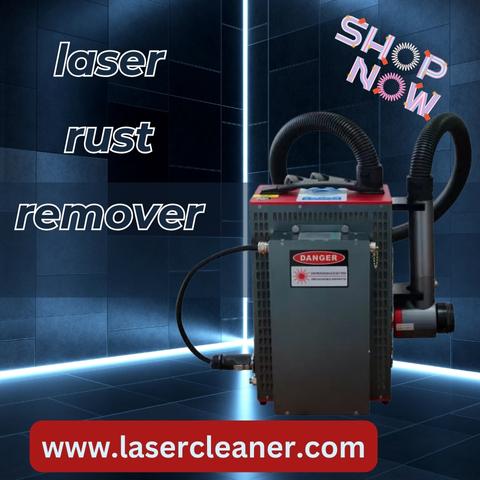Rust is one of the most common challenges faced when maintaining metal surfaces across industries, workshops, and even household projects. Over time, exposure to moisture, oxygen, and environmental pollutants causes iron and steel surfaces to corrode, reducing both their aesthetic appeal and structural integrity. Traditional methods of rust removal, such as sanding, chemical treatments, or abrasive blasting, often require significant labor, time, and resources. In contrast, laser rust remover provide a modern, precise, and efficient solution that addresses rust without the need for harsh chemicals or extensive surface preparation.
Laser rust removal works by directing a focused beam of laser energy onto the corroded surface. The laser’s energy heats the rust layer, causing it to expand and separate from the underlying metal. This process can remove even thin layers of rust while preserving the integrity of the base material. Unlike mechanical methods, the laser can access complex geometries, corners, and narrow cavities that are difficult to reach using brushes or abrasive tools.
Industries that deal with heavy machinery, automotive components, shipbuilding, and metal fabrication find laser rust removers particularly valuable. In automotive repair shops, for instance, laser technology can efficiently clean parts such as engine blocks, transmission components, and body panels before repainting or assembly. For industrial machinery, maintaining clean surfaces is essential to prevent further corrosion and ensure longevity, and lasers offer a contactless approach that reduces the risk of damaging sensitive components.
The precision of laser rust removal also makes it suitable for delicate applications. In aerospace and electronics manufacturing, even minor abrasions can compromise the performance of metal parts. Laser systems provide control over intensity, pulse duration, and scanning speed, allowing operators to remove corrosion without scratching, bending, or weakening the base material. This precision extends to restoration work as well, where historic machinery or artifacts can be cleaned and preserved without aggressive chemicals that might alter original surfaces.
Environmentally, laser rust removal presents a cleaner alternative to chemical treatments. Traditional methods often involve acids, solvents, or abrasive powders, which produce hazardous waste that requires careful disposal. Laser rust removers operate without chemical residues, generating minimal waste in the form of micro-particles that can be safely collected. This makes laser rust removal more sustainable, especially in workshops and factories where repeated cleaning is necessary.
Operating a laser rust remover involves understanding several technical parameters. The wavelength of the laser affects how energy is absorbed by rust versus the underlying metal. Pulse duration influences the efficiency of rust removal and the heat applied to the surface. Scanning patterns and movement speed determine the uniformity of cleaning across larger areas. Skilled operators can fine-tune these variables to achieve optimal results while minimizing risk to equipment or personnel. Many modern systems include automated scanning features, which allow consistent treatment of multiple parts and reduce manual labor requirements.
Safety considerations are critical when using laser systems. Protective eyewear, controlled environments, and proper ventilation are necessary to prevent accidents. Lasers generate intense light energy and may release fumes from the ablation of rust. Proper training ensures that operators handle the equipment safely and efficiently.
The versatility of laser rust removers extends beyond industrial applications. In construction, they can clean steel beams, rebar, and metal frames before painting or coating. In the marine sector, ships’ hulls and metal components exposed to saltwater environments benefit from precise rust removal that reduces surface damage and prepares the metal for protective coatings. Even hobbyists working on metal restoration projects can take advantage of compact laser systems designed for small-scale applications.
Recent technological advances have improved the accessibility and affordability of laser rust removers. Compact, handheld models now provide sufficient power for light to medium rust layers, while larger industrial systems offer high-speed cleaning for extensive surfaces. Integration with robotic arms or CNC systems allows fully automated rust removal processes in factories, further enhancing productivity and reducing manual effort.
Training and maintenance of laser systems are essential to maximize their lifespan and performance. Routine inspection of laser optics, cooling systems, and control software ensures consistent operation. In addition, operators need to understand the characteristics of different metal alloys, as certain metals may absorb laser energy differently, requiring adjustments to power and speed settings.
Laser rust removers are also finding applications in quality assurance and preventive maintenance. Regular cleaning of metal surfaces not only removes existing corrosion but also prepares surfaces for protective coatings, paints, or anti-corrosion treatments. By integrating laser rust removal into maintenance schedules, companies can extend the operational life of machinery and structures, reduce downtime, and maintain a professional finish on critical components.
For businesses and workshops considering the adoption of laser rust removal technology, selecting the right system depends on the scale of operations, types of metals processed, and desired cleaning precision. While investment in laser equipment is higher than traditional manual methods, the long-term benefits in efficiency, safety, and environmental impact make it a worthwhile solution for many industries.
Laser rust removal is more than just a tool; it represents a shift toward precision, sustainability, and efficiency in metal maintenance. As industries continue to prioritize high-quality outcomes, reduced waste, and streamlined workflows, laser rust removers offer a modern solution that addresses multiple challenges simultaneously. From heavy machinery to delicate components, their ability to clean without damaging the underlying metal ensures consistent results while maintaining the integrity of the parts being treated.
Final Thoughts
Laser rust remover provide a precise, efficient, and environmentally responsible method for tackling corrosion across a wide range of applications. Their adaptability, accuracy, and minimal environmental impact make them a valuable tool for industries, workshops, and restoration projects. By integrating laser rust removal into routine maintenance practices, businesses can enhance the longevity of their metal components while maintaining safety, quality, and performance standards.

